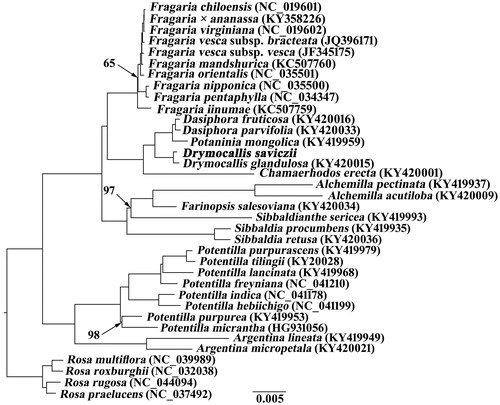Abstract
The complete chloroplast genome of Drymocallis saviczii was reported in the present study. The chloroplast genome of D. saviczii was a circular DNA molecule with a size of 154,487 bp in length. The genome had a typical quadripartite structure composed of a pair of inverted repeats (IRa and IRb) of 25,991 bp separated by a large single-copy (LSC) region of 84,332 bp and a small single-copy (SSC) region of 18,173 bp. The genome encoded a set of 129 genes, comprising 84 protein-coding genes, 37 tRNA genes, and eight rRNA genes. Phylogenetic analysis demonstrated that D. saviczii was closer to D. glandulosa in current sampling.
Drymocallis saviczii (Schischk. et Kom.) Soják [synonym: Potentilla saviczii Schischk. et Kom.] belongs to the family Rosaceae Juss., subfamily Rosoideae (Juss.) Arn., tribe Potentilleae Sweet. This species is distributed in the eastern half of Siberia in the Russian Far East and adjacent parts of north-eastern China (Soják Citation2004, 2007, Citation2011, Citation2012). The complete chloroplast (cp) genome of D. saviczii was reported and characterized herein, which provides significant information for further studies on its taxonomy and population genetics.
Fresh leaves of D. saviczii were collected from Arxan, Nei Mongol, China. Voucher specimen (no. Li QQ 20170822002) was deposited in the herbarium of Inner Mongolia Normal University (NMTC). Total genomic DNA was extracted using the method of Doyle and Doyle (Citation1987). Short-insert library (insert size, 300 bp) was prepared and then sequenced using the Illumina HiSeq platform in Novogene (Nanjing, China). A total of 36,860,588-bp raw reads were generated by Illumina paired-end sequencing after removing adapters. The raw reads were used to assemble the cp genome in NOVOPlasty (Dierckxsens et al. Citation2017), with ribulose-1, 5-bisphosphate carboxylase/oxygenase (rbcL) gene from D. glandulosa (GenBank accession no. KY420015) as the seed sequence. Chloroplast genome annotation was conducted using transferring annotations in Geneious Prime (Kearse et al. Citation2012), with the complete cp genome of Farinopsis salesoviana (Steph.) Chrtek et Soják (GenBank accession no. MT017928) as the reference. Where necessary, gene boundaries were manually corrected to match the start and stop codons and intron/exon boundaries. The annotated complete cp genome of D. saviczii was submitted to GenBank with the accession no. MT178809. The complete cp genome of D. saviczii was a circular DNA molecule with a size of 154,487 bp in length. The genome had a typical quadripartite structure, which composed of two copies of inverted repeats (IRa and IRb: 25,991 bp) separated by two regions: the large single-copy region (LSC: 84,332 bp) and the small single-copy region (SSC: 18,173 bp). The total GC content was 37.2%, and those of the LSC, SSC and each IR were 35.1%, 30.9%, and 42.8%, respectively. The cp genome encoded a set of 129 genes, comprising 84 protein-coding genes, 37 tRNA genes, and eight rRNA genes.
To examine the phylogenetic position of D. saviczii, the cp genome sequences of D. saviczii and 31 related species in Potentilleae plus four Rosa species were aligned by MAFFT version 7.450 (Katoh and Standley Citation2013) and trimmed properly using trimAL version 1.4 (Capella-Gutiérrez et al. Citation2009). The maximum likelihood (ML) tree was inferred using RAXML version 8 (Stamatakis Citation2014), with the combined rapid bootstrap analysis (1000 replicates) and search for best-scoring ML tree (the ‘-f a’ option). The GTRGAMMA model was used in the analysis. Phylogenetic tree demonstrated that D. saviczii was closer to D. glandulosa than to other species in current sampling ().
Disclosure statement
No potential conflict of interest was reported by the author(s).
Data availability statement
The authors confirm that the data supporting the finding of this study are available within its supplementary material.
Additional information
Funding
References
- Capella‐Gutiérrez S, Silla‐Martínez JM, Gabaldón T, 2009. trimAl: a tool for automated alignment trimming in large‐scale phylogenetic analyses. Bioinformatics. 25(15):1972–1973.
- Dierckxsens N, Mardulyn P, Smits G. 2017. NOVOPlasty: de novo assembly of organelle genomes from whole genome data. Nucleic Acids Res. 45(4):e18.
- Doyle JJ, Doyle JL. 1987. A rapid DNA isolation procedure for small amounts of fresh leaf tissue. Phytochem Bull. 19(1):11–15.
- Katoh K, Standley DM. 2013. MAFFT multiple sequence alignment software version 7: improvements in performance and usability. Mol Biol Evol. 30(4):772–780.
- Kearse M, Moir R, Wilson A, Stones‐Havas S, Cheung M, Sturrock S, Buxton S, Cooper A, Markowitz S, Duran C, et al. 2012. Geneious Basic: an integrated and extendable desktop software platform for the organization and analysis of sequence data. Bioinformatics. 28(12):1647–1649.
- Soják J. 2004. Potentilla L. (Rosaceae) and related genera in the former USSR (identification key, checklist and figures). Notes on Potentilla XVI. Bot Jahrb Syst. 125(3):253–340.
- Soják J. 2007. Potentilla (Rosaceae) in China. Notes on Potentilla XIX. Harv Pap Bot. 12(2):285–324.
- Soják J. 2011. Synopsis of Drymocallis Fourr. ex Rydb. (Rosaceae–Potentilleae) in the old world. Ann Naturhist Mus Wien, B. 112:319–328.
- Soják J. 2012. Potentilla L. (Rosaceae) and related genera in Asia (excluding the former USSR), Africa and New Guinea. Notes on Potentilla XXVIII.Plant Div Evol. 130(1-2):7–157.
- Stamatakis A. 2014. RAxML version 8: a tool for phylogenetic analysis and post-analysis of large phylogenies. Bioinformatics. 30(9):1312–1313.

